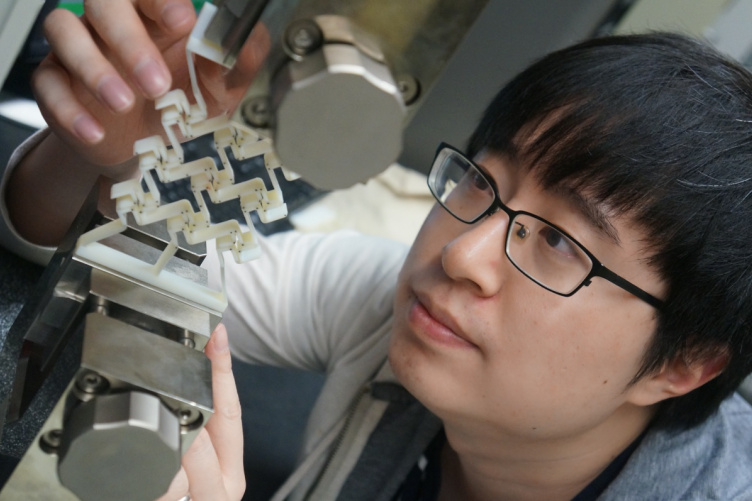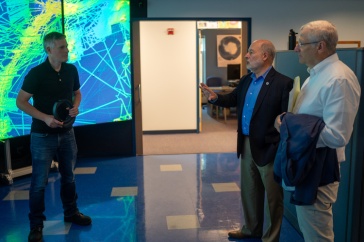
Yunyao Jiang, a doctoral candidate in mechanical engineering at UNH, using a 3D-printed prototype to prove the concept of a sequential cell-opening mechanism.
Inspired by a color changing mechanism found in cephalopods, like squid, cuttlefish and octopus, researchers at the University of New Hampshire have conceived a design for a unique sequential cell-opening mechanism that has many potential applications from drug delivery to color altering camouflage materials.
The novel concept has broad probable uses in designing smart materials that can not only be responsive to external conditions like light, temperature, and humidity, but can also be developed into sensors, and materials for particle release, drug delivery and color changing camouflage. Specific examples include biomedical scaffolds, drug-release bandages, drug reservoirs and stents, innovative foldable or deployable devices, smart responsive composites and stretchable soft electronic materials. There is a pending patent which has been filed by UNHInnovation, which advocates for, manages, and promotes UNH’s intellectual property.

The research team created the concept by modifying the chiral geometry of two different cells that were designed to mimic the color-changing organs, or chromatophores, in the cephalopods. When loaded only in one direction, the two different cells (one large and one small) with different attributes, would open sequentially, one after the other. A multi-material 3D printer was instrumental in fabricating a fast prototype of the design and help prove the concept that used complicated geometry and materials. The study is a cover story for Advanced Engineering Materials.
“We used two different types of cells, one would open right away and the other would rotate first before opening in the sequence,” said Yaning Li, assistant professor of mechanical engineering at UNH and one of the authors. “What makes this unique is that if each cell is assigned a different color, you could alter the sequential opening mechanism to create a material that might be dark green when the first cell opened and then change to bright yellow when the second one opened after it. This concept could also be used for particle release, such as two different medicines being released sequentially through a bandage to help address medical issues like wound swelling.”
To prove the concept, the researchers created an innovative soft meta-material, discussed in an earlier study by the team. By customizing the chiral geometry at two different levels, the different size cells that were loaded only in one direction did open sequentially.
“The order of the cell opening can also be altered via geometry and material combination to alter the behavior of the cells and increase the number of potential applications,” said Yunyao Jiang, a doctoral candidate in mechanical engineering at UNH, and lead author.
This work was supported by a NSF/CAREER award to explore the mechanics of auxetic chiral metamaterials via innovative design and 3D printing.
For more information on licensing this patent-pending technology, contact unh.innovation@unh.edu.
-
Written By:
Robbin Ray ’82 | UNH Marketing | robbin.ray@unh.edu | 603-862-4864




















































